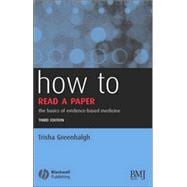
- Web based teaching and learning, especially for health care professionals
- Evidence based health care and quality improvement, especially in relation to multiprofessional and interdisciplinary working
- Health service management, especially organisation, delivery and evaluation of diabetes services in primary care
- Use of personal narrative to explore the patient's perspective and illness experience, especially in relation to diabetes in minority ethnic groups
| Foreword to the First Edition by Professor Sir David Weatherall, | ix | ||||
| Preface to the Third Edition, | xi | ||||
| Preface to the First Edition: do you need to read this book? | xiii | ||||
| Acknowledgements, | xv | ||||
| Chapter 1: Why read papers at all? | 1 | (14) | |||
|
1 | (2) | |||
|
3 | (6) | |||
|
9 | (6) | |||
| Chapter 2: Searching the literature, | 15 | (25) | |||
|
15 | (2) | |||
|
17 | (3) | |||
|
20 | (1) | |||
|
21 | (2) | |||
|
23 | (1) | |||
|
24 | (1) | |||
|
24 | (1) | |||
|
25 | (1) | |||
|
26 | (14) | |||
| Chapter 3: Getting your bearings: what is this paper about? | 40 | (19) | |||
|
40 | (2) | |||
|
42 | (2) | |||
|
44 | (5) | |||
|
49 | (1) | |||
|
50 | (1) | |||
|
51 | (1) | |||
|
52 | (1) | |||
|
53 | (1) | |||
|
53 | (6) | |||
| Chapter 4: Assessing methodological quality, | 59 | (14) | |||
|
59 | (1) | |||
|
60 | (1) | |||
|
61 | (1) | |||
|
62 | (4) | |||
|
66 | (1) | |||
|
67 | (3) | |||
|
70 | (3) | |||
| Chapter 5: Statistics for the non-statistician, | 73 | (17) | |||
|
73 | (1) | |||
|
74 | (5) | |||
|
79 | (2) | |||
|
81 | (2) | |||
|
83 | (3) | |||
|
86 | (2) | |||
|
88 | (2) | |||
| Chapter 6: Papers that report drug trials, | 90 | (10) | |||
|
90 | (2) | |||
|
92 | (1) | |||
|
93 | (3) | |||
|
96 | (4) | |||
| Chapter 7: Papers that report diagnostic or screening tests, | 100 | (14) | |||
|
100 | (1) | |||
|
101 | (4) | |||
|
105 | (5) | |||
|
110 | (4) | |||
| Chapter 8: Papers that summarise other papers (systematic reviews and meta-analyses), | 114 | (20) | |||
|
114 | (3) | |||
|
117 | (5) | |||
|
122 | (4) | |||
|
126 | (4) | |||
|
130 | (4) | |||
| Chapter 9: Papers that tell you what to do (guidelines), | 134 | (18) | |||
|
134 | (3) | |||
|
137 | (5) | |||
|
142 | (10) | |||
| Chapter 10: Papers that tell you what things cost (economic analyses), | 152 | (14) | |||
|
152 | (2) | |||
|
154 | (5) | |||
|
159 | (4) | |||
|
163 | (3) | |||
| Chapter 11: Papers that go beyond numbers (qualitative research), | 166 | (14) | |||
|
166 | (4) | |||
|
170 | (7) | |||
|
177 | (3) | |||
| Chapter 12: Papers that report questionnaire research, | 180 | (11) | |||
|
180 | (1) | |||
|
181 | (10) | |||
| Chapter 13: Getting evidence into practice, | 191 | (21) | |||
|
191 | (2) | |||
|
193 | (5) | |||
|
198 | (2) | |||
|
200 | (5) | |||
|
205 | (7) | |||
| Appendix 1: Checklists for finding, appraising and implementing evidence, | 212 | (8) | |||
| Appendix 2: Assessing the effects of an intervention, | 220 | (1) | |||
| Index, | 221 |
The New copy of this book will include any supplemental materials advertised. Please check the title of the book to determine if it should include any access cards, study guides, lab manuals, CDs, etc.
The Used, Rental and eBook copies of this book are not guaranteed to include any supplemental materials. Typically, only the book itself is included. This is true even if the title states it includes any access cards, study guides, lab manuals, CDs, etc.